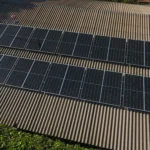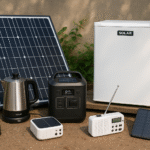Ever wondered if your solar panels could do more than just power your home? What if they could generate passive income while still supplying clean energy? That is precisely what a solar miner aims to do.
In this post, you will learn how solar mining works, its benefits and drawbacks, what equipment you need, and whether it is worth the investment for you.

How Does a Solar Miner Work?
A solar is a hybrid setup that utilizes solar panels to power cryptocurrency mining hardware. Instead of drawing electricity from the grid, which is expensive and often generated from fossil fuels, it harnesses solar-generated electricity to run devices that mine coins like Bitcoin or Ethereum.
This pairing not only reduces your carbon footprint but also turns your rooftop into a money-generating asset.
Real-World Scenario
In California, a homeowner named Rafael installed a 6 kW solar system and used it to power a small Ethereum mining rig. His goal was not to become a full-time miner, but rather to offset electric bills and generate passive income. After refining his setup, he earned around $45 to $70 a month in crypto. All of this came from sunlight.
Also click hare : solar electrice fance
The Pros and Cons of Using a Solar Miner
Combining solar energy with crypto mining has its clear benefits, but it also presents a few technical and financial challenges that you should understand upfront.
Solar mining isn’t for everyone, but when done right, it can enhance your solar ROI and sustainability efforts.
Pros
Passive Income: Generates crypto using energy your panels already produce
Lower Environmental Impact: Cleaner than grid-powered mining
- Maximizes Your Solar ROI: Makes use of excess daytime electricity
- Grid Independence: Less reliance on peak-time electricity prices
- Offset Electric Bills: Earnings from mining can help cover solar maintenance or storage costs
Cons
- Technical Complexity: Requires monitoring energy loads, firmware, and miner performance
- Cooling Requirements: Mining rigs generate heat and may need ventilation
- Initial Costs: Hardware can add $1,000 or more to your setup
- Noise and Vibration: Can be disruptive without soundproofing or insulation
- Regulatory Restrictions: Some utilities or HOAs may prohibit high-load setups

What You’ll Need to Get Started
To build a basic solar miner setup, you’ll need both energy-generating and crypto-mining equipment. Proper planning and compatible components are key to achieving efficiency and long-term gains.
If you already own solar panels, you are one step ahead. But even then, upgrading your inverter or adding smart load control may be necessary.
Equipment Checklist
- Solar Panels: A 5 kW to 10 kW system is recommended
- Hybrid Inverter: Must support smart load management
- Solar Battery (Optional): Stores energy for nighttime mining
- Mining Rig: ASIC miners for Bitcoin or GPUs for other coins
- Monitoring Software: NiceHash, HiveOS, or CGMiner
- Cooling Gear: High-speed fans or liquid cooling setups
According to Energy.gov, many solar panel owners are now integrating smart systems to manage their energy use better. A mining rig is one example of a load that can be automated to run only during solar production hours.
Tips to Optimize Your Solar Setup
Once your hardware is installed, you will need to manage it carefully. Unlike passive solar power use, mining adds a constant energy demand to your system. Optimization is crucial to ensure the added load does not reduce your home’s energy performance.
1. Clean Your Panels Regularly
Dirty solar panels can reduce output by up to 20 percent. Dust, bird droppings, and leaves block sunlight. Clean your panels at least every 3 months, or more frequently in dusty climates.
2. Use Smart Load Prioritization
You should never mine at the expense of powering essential appliances. Smart panels or load controllers like the Span Panel allow you to schedule when different systems receive power.
3. Keep Mining Rigs Cool
Mining hardware can run hot. Use well-ventilated garage spaces or invest in airflow management. Maintain indoor temperatures between 60 and 80°F for best results.
4. Track System Performance
Use monitoring tools such as Enphase Enlighten or SolarEdge to compare generation versus consumption. If your miner consumes more than your panels produce, it may eat into your savings.
5. Understand Local Rules
Some states or HOAs limit home-based crypto mining due to its electrical load. Always check local regulations before starting a solar mining project.

Is It Worth It? ROI Breakdown
Many people ask whether combining solar energy with crypto mining is worth the investment. The answer depends on energy prices, panel efficiency, miner performance, and market fluctuations.
Let’s break it down with a rough estimate.
| Component | Estimated Cost |
|---|---|
| 6.6 kW Solar System | $10,000 to $12,000 (after credits) |
| Mining Hardware | $1,200 to $2,000 |
| Battery Storage (Optional) | $6,000 to $8,000 |
| Monitoring Tools | $200 to $500 |
| Crypto Yield | $40 to $100 per month |
Estimated Payback Period: 4 to 7 years, depending on your mining efficiency and local electric rates.
Use the PVWatts Calculator by NREL to estimate how much energy your system could generate based on your zip code.
Also click here : solar uses
Troubleshooting Common Solar Miner Issues
Like any hybrid setup, your solar may occasionally underperform. Here are practical steps to resolve common issues before calling a technician.
Maintaining both your solar system and mining rig ensures that neither limits the performance of the other.
Troubleshooting Checklist
- Check for Shading: Tree limbs or debris can reduce panel efficiency
- Inverter Errors: Look for blinking lights or fault codes on your inverter
- High Miner Temps: Reduce overclocking or move to a cooler location
- Grid Draw at Night: Ensure mining is paused after sunset if no battery is installed
- Declining Crypto Yield: Reconfigure your pool or switch coins if necessary
Can You Use a Solar Miner Alongside an EV Charger?
Many homeowners wonder if they can run both an electric vehicle (EV) charger and a mining rig from the same solar system. The answer is yes, but only with smart energy management.
Solar systems often cannot support both loads at the same time without assistance from battery storage or intelligent switching.
How to Manage Dual Loads
- Stagger Usage: Schedule your EV charging in the morning and mining in the afternoon
- Use Load Controllers: Prioritize one device at a time using smart systems
- Add Battery Storage: Allows you to mine or charge your car even after sunset
According to several installers I have worked with, battery-supported solar systems are the most flexible when managing multiple large loads like EVs and mining rigs.
Client Case Study: Combining Solar and Crypto in a Workshop
Earlier this year, I consulted with a small metalworking business in Phoenix that wanted to reduce energy bills. They installed a 10 kW solar system with a hybrid inverter and battery. During the day, the system powered their workshop tools. After hours, the same system was used to run a small Bitcoin mining rig.
Over the course of 12 months, the crypto earnings averaged $150 per month. This helped offset their battery loan payment, demonstrating that solar miners can also operate in commercial settings.

Ready to Maximize Your Solar Investment?
If your solar panels haven’t been cleaned in over three months, you could be losing 10 to 20 percent of your energy output. This not only impacts your home energy use but also reduces mining profitability. Schedule a system inspection today and start turning every ray of sunshine into savings.
Frequently Asked Questions
What is a solar miner?
A solar is a setup that utilizes solar-generated electricity to power cryptocurrency mining equipment. It enables homeowners to mine coins like Bitcoin or Ethereum without relying on traditional grid electricity.
Is solar mining profitable?
Solar mining can be profitable if your system produces enough excess energy and your hardware is efficient. Typical home miners earn $40 to $100 per month, depending on the setup and energy rates.
How much will a 6.6 kW solar system save me?
A 6.6 kW system can save between $800 to $1,200 per year on electricity, depending on your location, energy usage, and sunlight hours. Adding a mining rig can increase these savings.
How many solar panels does it take to run a Bitcoin miner?
Running a single ASIC Bitcoin miner, such as the Antminer S19, requires about 3,250 watts. This would need at least 8 to 10 standard 400-watt solar panels operating at full efficiency during daylight hours.
How much can a Bitcoin miner earn per day?
Bitcoin miner earnings vary by hardware and market conditions. On average, a typical ASIC miner may earn $1 to $5 per day after electricity costs when powered by grid energy. With free solar power, these margins improve.











